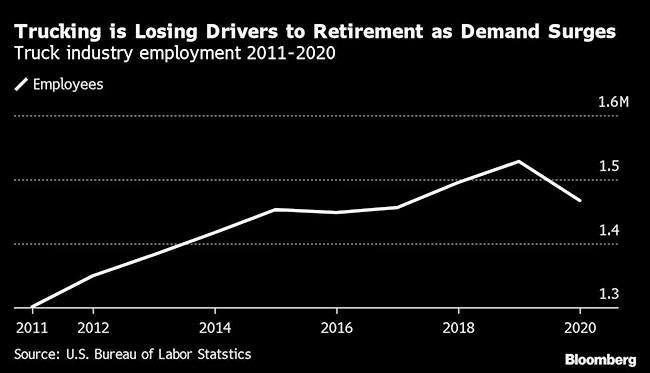Bloomberg News
Teen Truck Drivers Seen as Way to Alleviate Shortage

[Stay on top of transportation news: Get TTNews in your inbox.]
Dezjion Henson has wanted to be a truck driver his whole life. When he turned 18 last year, he jumped at the chance and signed on as an apprentice with Total Transportation of Mississippi in Richland.
“Growing up, my dad used to drive trucks and I used to always ride with him,” he said. “I said that’s something I really want to do.”
He assumed he would have to wait until he turns 21 to book the lucrative, cross-country runs he took with his father. But the new infrastructure law signed by President Joe Biden will let some drivers as young as 18 make interstate trips, a move aimed at easing the nation’s supply chain squeeze but one that raises safety concerns.
The three-year pilot program was opposed by safety advocates who point out that teenagers crash at four times the rate of older drivers. But it was included in the infrastructure law at the urging of the industry, which says it is 80,000 drivers short of where it needs to be to meet demand projections.

That lack of drivers has sent a ripple through the economy, contributing to backups at ports and kinks in the supply chain that threaten delivery of holiday gifts. Like lowering the age of drivers, some of the other proposals for government action to get more people behind the wheel raise their own safety concerns.
A proposal to relax federal rest requirements, for example, has been mired in controversy since the Obama administration. But there is renewed pressure to do it as a way to ease the backlog.
“Regulatory flexibilities, especially during emergencies, are vital to supply chain continuity,” a coalition of about 100 different trucking-related associations wrote in a Nov. 3 letter to Biden.
The Department of Transportation’s rules limit truckers to 11 hours in a work day and 70 hours in a week. Also, they have to be given at least one 30-minute break during the first eight hours of their shift. An exemption put in place by the Trump administration last year allows drivers making trips within a few hours of their starting point to work a 14-hour shift.
Safety groups have said Congress should steer clear of relaxing the scheduling rules for truckers.
“Long workdays, excessive driving hours, and unreasonable delivery demands jeopardize the safety of truck drivers and motorists,” Dawn King, president of the Truck Safety Coalition, said in a statement.
The coalition of industry groups that represents frequent shippers that wrote to Biden includes American Trucking Associations, the Agricultural Retailers Association, the American Farm Bureau Federation, and American Frozen Food Institute. They also want truckers to be left out of the federal vaccine mandate that is on hold after a federal court temporarily halted implementation. The industry argues that truck drivers should be exempt because they spend most of their time driving alone.
National truck driver shortage raises questions about age requirement https://t.co/bvN8S4PUAP — KTVB.COM (@KTVB) November 24, 2021
“We’re not anti-vaccine, but in our our survey of 120,000 truckers, 50% were vaccinated and 50% weren’t vaccinated,” said Bill Sullivan, ATA’s executive vice president for advocacy. “Thirty-seven percent of all drivers said they would go to a company that doesn’t have a vaccinate mandate or leave the industry all together.”
Greg Regan, president of the AFL-CIO’s Transportation Trades Department, last month told a House committee that his union “wants to make sure that every worker has the protections” of the Occupational Safety and Health Administration’s vaccine mandate that applies to companies with 100 or more employees.
For the foreseeable future, lowering the minimum age to haul cargo across state lines appears to be the closest to being enacted.
Total Transportation of Mississippi CEO John Stomps, 66, said lowering the age limit is likely the only way to address the supply chain crunch as it relates to trucks.
“Older drivers are leaving and retiring, and we’re not bringing in younger drivers to replace them fast enough,” he said.
It’s grueling work. Long distance truck drivers average about 125,000 miles per year and spend an average of 300 days on the road, according to the Woodford, Va.-based CDS Tractor Trailer Training school. The median pay for the position in 2020 was $47,130 per year, according to the U.S. Bureau of Labor Statistics.
The trucking industry employed 3.36 million truck drivers in 2020, down 6.8% from 3.5 million in 2019, according to ATA.
The pilot program in the $550 billion infrastructure law allows those as young as 18 to drive across state lines if they complete at least 400 hours of duty time. A similar program already was in existence for drivers who operated trucks in the military.
New York has become the final state to lower the qualifying age for a CDL Class A license to 18. The legislation, co-sponsored by @DonnaLupardo, aims to fill the tens of thousands of open truck driver jobs. https://t.co/6V7i9RRtue — Amy Hogan (@AmyHoganTV) November 30, 2021
Safety advocates say allowing teenagers to drive big rigs on long interstate trips is dangerous.
Cathy Chase, president of Advocates for Highway and Auto Safety, said lowering the truck driver age limit would put “inexperienced, risk-prone teenagers” behind the wheel of 80,000-pound trucks traveling on interstate highways.
Russ Swift, co-chair of Parents Against Tired Truckers, said in a statement, “Allowing teens to drive big rigs across state borders in the face of research showing that this age group has significantly higher fatal crash rates is reckless and dangerous.
“An empty store shelf is not as tragic as an empty chair at Christmas dinner because your loved one needlessly died in a crash caused by a teen trucker.”

Big rig braking is an engineering marvel. Host Michael Freeze finds out more about the advanced technology that halts 18-wheelers, no matter the weight, instantaneously. Hear a snippet above, and get the full program by going to RoadSigns.TTNews.com.
Supporters note that 49 states and the District of Columbia allow individuals to obtain a commercial driver license at the age 18. New York is the exception, requiring all drivers to wait until they are 21.
ATA’s Sullivan said truck companies are committed to safety, even as they push to bring on younger drivers.
“The last thing any of our members want to do is do this unsafely,” he said. “We want to produce a driver who is at least as safe as a 21-year-old.”
For his part, Total Transportation’s Henson hopes to do his part to ease the backlogs by making long-distance runs when he completes his interstate driving program. He is halfway through and will have to drive 400 hours before he can take the wheel alone.
“I still see the full potential to be a trucker,” he said. “Trucks can go anywhere. We supply the food. We need more drivers to drive.”
Want more news? Listen to today's daily briefing below or go here for more info:
Distributed by Tribune Content Agency, LLC




